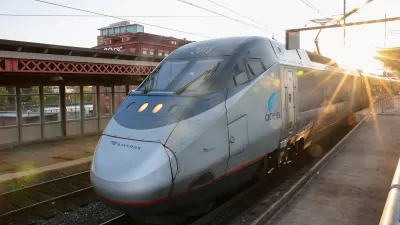Burgess Everett and Adam Snider look at the growing debate over where to allocate limited high-speed rail funds: on the East Coast, where rail already has a foothold, or out West, where California has the land and starter funds to make it happen.
Seen as a "shining savior" to those looking to reduce congestion and efficiently move millions of people, the contruction of high-speed rail throughout the United States (as President Obama had hoped) is being contrained by geography and limited funds. As such, HSR supporters are enmeshed in a debate over where to focus limited resources.
According to Everett and Snider, "lawmakers are torn between how to use limited funds: along the densely
packed East Coast, which has a history of commuter rail, or out West,
where California has ponied up billions of dollars to build a high-speed
system, much of it from scratch."
California has a head start, with $6 billion already allocated to the first phase of their HSR project, which could break ground this year. However, California's push is facing challenges at home and in D.C.
"In Washington, freshman Rep. Jeff Denham (R-Calif.), a member of the
House Transportation and Infrastructure Committee, has pushed to
concentrate high-speed rail efforts in the Northeast, not back home.
"I've looked deep into California high-speed rail, and they continue
to change the number, and it doesn't pencil out. There's a lot of
hypothetical numbers - you can build a better business plan somewhere
like the Northeast [Corridor], where you've already got ridership
numbers and current travel times," he said.
FULL STORY: High-speed rail's competing visions

Alabama: Trump Terminates Settlements for Black Communities Harmed By Raw Sewage
Trump deemed the landmark civil rights agreement “illegal DEI and environmental justice policy.”

Planetizen Federal Action Tracker
A weekly monitor of how Trump’s orders and actions are impacting planners and planning in America.

The 120 Year Old Tiny Home Villages That Sheltered San Francisco’s Earthquake Refugees
More than a century ago, San Francisco mobilized to house thousands of residents displaced by the 1906 earthquake. Could their strategy offer a model for the present?

Indy Neighborhood Group Builds Temporary Multi-Use Path
Community members, aided in part by funding from the city, repurposed a vehicle lane to create a protected bike and pedestrian path for the summer season.

Congestion Pricing Drops Holland Tunnel Delays by 65 Percent
New York City’s contentious tolling program has yielded improved traffic and roughly $100 million in revenue for the MTA.

In Both Crashes and Crime, Public Transportation is Far Safer than Driving
Contrary to popular assumptions, public transportation has far lower crash and crime rates than automobile travel. For safer communities, improve and encourage transit travel.
Urban Design for Planners 1: Software Tools
This six-course series explores essential urban design concepts using open source software and equips planners with the tools they need to participate fully in the urban design process.
Planning for Universal Design
Learn the tools for implementing Universal Design in planning regulations.
Clanton & Associates, Inc.
Jessamine County Fiscal Court
Institute for Housing and Urban Development Studies (IHS)
City of Grandview
Harvard GSD Executive Education
Toledo-Lucas County Plan Commissions
Salt Lake City
NYU Wagner Graduate School of Public Service




























